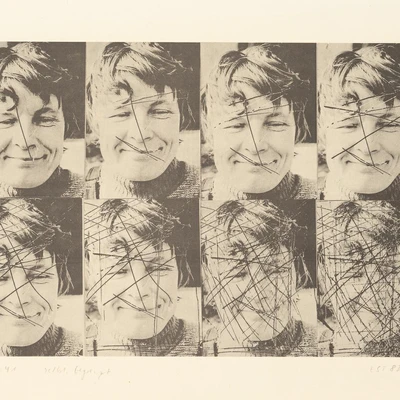Klaus Drechsler
- * 1940
Life dates
- Artist
Category
Brush, Rock, Paper
Klaus Drechsler is enough of a realist to recognize that the quasi-realistic representation of the world around him is in itself a more than adequate challenge. Thus he seeks, through exploration of the graphic form and with admirable mastery of printing techniques, to get closer to the people who cross his path. The pictures he made in 1979 and 1980 testify to his finesse in using the techniques of the color lithograph and the silkscreen. Drechsler, in these portraits, tickles out with virtuosity the unique character of each of his subjects. Reserved in his use of color, he concentrates on the interplay of light and shadow. He thus attains a stupendous degree of vibrancy: you almost imagine that the subject is seated or standing right in front of you, that you feel on your own arm the same sun that softens the skin of the man looking at you with his questioning eyes. In his aquatint of a quarry worker, the individual seems to retreat from the foreground; he becomes one with his tool and with the material it belabors, so that the worker, in extracting the rock from its landscape, seems to extract himself along with it.
Klaus Drechsler, born 1940 in Ober-Dammer, today Dąbrowa Górna, in Poland, emigrated in 1947 to the Oberlausitz, where he attended, from 1957 to 1960, the school for workers and farmers at the Hochschule für Bildende Künste Dresden. This was followed by a university degree in art (1961 – 1966) and a period as senior research assistant (1966 – 1969) at the same institution. From 1969 on, Drechsler has lived and worked as an independent artist in Dresden-Wachwitz. From 1966 to 2006, he served as artistic director of the Painting and Drawing Circle of Pirna-Sonnenstein e.V. He also led art therapy courses and lectured at the Technische Universität Dresden (1990 – 2006) as well as the Hochschule für Bildende Künste Dresden (1994 – 2002). From 1966 to 1990, he was a member of the GDR’s Verband der Bildenden Künstler (Association of Visual Artists); and since 1991 has been a member of the Sächsischer Künstlerbund (Artists’ Union of Saxony). His works have been frequently exhibited and are in the collections of numerous public institutions.
Besides his intensive and constant preoccupation with graphic arts techniques – intaglio printing, but more especially multi-color silkscreens, color lithographs and algraphs (aluminum die-casting) – Klaus Drechsler continued to develop his oeuvre of drawings and paintings, creating a large number of still lifes, portraits of men and women, and landscapes. Drechsler’s drawings, with their highly energetic lines and a choice of subjects which reveals more freedom and a more critical response to his times, form an intriguing contrast to the paintings, watercolors, and color prints, which are characterized by the interplay of patches of color in modest hues. Starting in 1997, the artist also devoted significant time to sculpture, creating numerous small-format bronzes as well as works for the public space.
For all the broad span of techniques and approaches that went into creating his œuvre, Klaus Drechsler remained faithful to a representational language, knowing full well that reality can be surreal enough as it is.
text: Anke Paula Böttcher, translation: Darrell Wilkins
Works by Klaus Drechsler
Travelling exhibition
Publik machen: 40 Künstler:innen aus dem Bestand des Zentrums für Kunstausstellungen der DDR
Popular keywords
Many more works are hidden behind these terms
